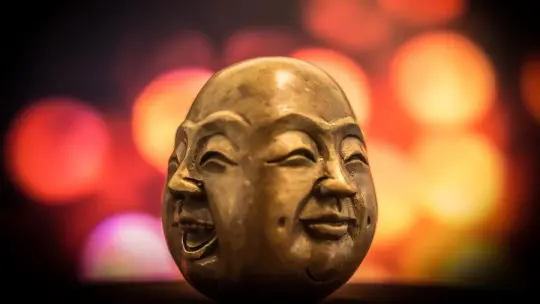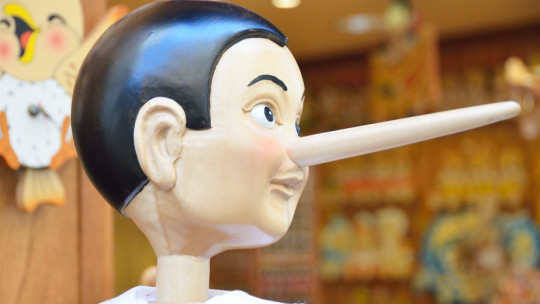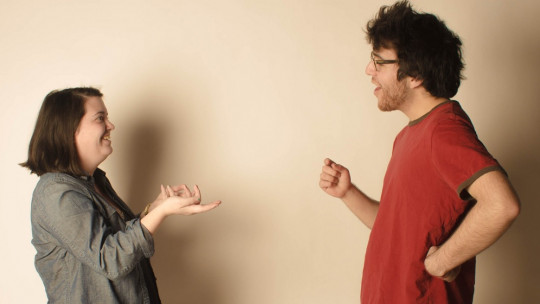
When we talk about communication, we generally tend to think first of verbal language (whether oral or written) as a means of expressing ideas, feelings, intentions and emotions. The messages emitted in this way tend to be almost always totally conscious and voluntary, controlling and choosing both what we say and what we do not say.
However, it must be taken into account that everything, and not just verbal, is communicative: from distances to posture, including gestures, it transmits information. This is part of non-verbal language.
And not in all of the aforementioned aspects we have the same control: for example, although we can consciously use gestures during our speech, we also continually emit body expressions and gestures unconsciously and involuntarily, which can reveal our thoughts, feelings or even elements of our personality without intending to. As an example, in this article We are going to see a series of gestures that betray us revealing aspects of ourselves unconsciously.
The main types of language
As we have seen, every act and even the absence of it is communicative. When evaluating a communicative exchange between two or more people, we usually take into account two types of language: verbal and non-verbal.
Verbal language would refer to verbal or written communication through the use of words as symbolic element of information representation being the content of the message what is relevant.
Regarding non-verbal language, it integrates the set of elements through which we transmit information regardless of the verbal content that we are or are not expressing. Non-verbal language is in turn integrated by proxemics, paraverbal language and kinesic language.
Proxemics is the use of distances as a communicative element, and paraverbal language is configured by the set of qualities of the voice or the use of the word that do not refer to the content but to the format such as intonation or the volume used. With regard to kinesics or kinesic language, this integrates the set of movements, gestures, expressions and postures that we carry out during the communicative act and that are capable of transmitting information, this being capable of modulating the perception, meaning and interpretation of the message.
A dozen gestures that give you away
There are many gestures that we carry out throughout the day, often being used voluntarily. However, we are not so used to controlling our expressions and we often do not even realize that we are carrying them out, revealing parts of our psyche or way of taking the interaction with others in an unconscious way. Some gestures are uncontrollable, and cannot be forced naturally. But others can be changed if we realize it and get used to doing them or not doing them.
Below we are going to show a dozen gestures that betray us in our interactions, as well as their general meaning. Now, it must be taken into account that each person is a world and the same gesture can have very different interpretations depending on the personality or postural habits of the person doing it, or the situation.
Thus, although the gestures that we are going to mention often have a specific meaning, seeing a person perform a certain gesture does not necessarily imply that they are feeling a specific emotion, expressing a specific facet of personality or reacting in a specific way to the communicative exchange. .
1. Arms crossed over the chest
An easily visible classic, this gesture is usually used in case of anger or impatience towards another person or situation. However, it is also established as a gesture that involves the need to establish a separation or barrier between ourselves and the other whether due to insecurity or even disinterest.
If this gesture is considered necessary, it can be easily avoided on a physical level, although it may be useful to work on frustration tolerance or carry out training to promote self-confidence.
2. Arms on hips
Grabbing our hips with our hands can have two basic, largely contrasting meanings. The first of them and probably the best known is the one associated with the existence of anger or impatience, while on the other hand it can also indicate a lack of security that makes us try to make ourselves bigger under the observation of others.
In reality, both interpretations have something in common: they are linked to adopting a defensive posture and showing security, making ourselves more visible whether we do it from a more aggressive perspective or if we do it as a method to try to protect ourselves.
The way to avoid performing this gesture is first of all to listen to yourself and understand our emotional reaction to circumstances or people looking for an alternative or solution to what generates the need to do it.
3. Handshake
One of the possible gestures that betray us since they can give more information than intended occurs when we give or someone shakes our hand. Although it is a type of conscious movement, it includes aspects that may escape control, such as the level of force that is applied or whether or not it is accompanied by another type of physical contact.
A contact without force or in which only the fingers touch usually expresses little confidence and self-assurance, nervousness rejection or a lack of interest in the interaction itself.
On the contrary, A squeeze that is too strong can convey the idea of wanting to overwhelm the other person, assuming a dominant and aggressive posture although at the same time it can show security and assertiveness. If we add another touch, such as grabbing the forearm with the other hand, we may be suggesting either a desire for closeness or an attempt to exert control over the situation or interaction. Nervousness can also be expressed in the form of sweat.
The ideal would be to try to control your nerves before shaking hands, as well as to previously rehearse with other people the level of force to be applied in the shake, which should be firm and decisive but gentle enough not to be aggressive. If you sweat, it may be advisable to dry your hands before giving it, in a way that is natural and inconspicuous (for example, hidden against your pants).
4. Shoulder orientation
We often don’t realize how expressive parts like shoulders can be. The orientation and inclination of these forward, towards the other, generally suggests interest (regardless of what type of interest it is) in the person with whom we interact or in what they are telling us. On the other hand, if the shoulders are directed towards the sides of the body or backwards, it may indicate indifference, disinterest or boredom.
In this sense, the knowledge of this fact and the correction of posture can be controlled if we are aware of it, projecting the shoulders as desired or maintaining the same posture throughout the interaction.
5. Swell the chest
The act of puffing out the chest is a gesture that may be unconscious and may reflect an attempt to appear larger, being used as a gesture to try to impress or show strength. It can be a defensive or even aggressive gesture.
In another context, in both men and women and regardless of sexual orientation, the act of puffing out the chest is used at an unconscious level. in front of people who are stimulating and attractive to us. In this sense, men inflate their chests to show power and increase their figure, while women tend to look for positions that highlight their breasts.
If we do not want to show this interest and the gesture is unconscious, it will not be possible to stop it, but it is possible to do muscle tension and breathing training that makes it easier to scan and realize said gesture.
6. Avoid looking
Avoiding our interlocutor’s gaze is generally a symptom of nervousness, and it is one of the gestures that betray us in different situations. This nervousness can come from different types of situations and emotions: it is common for people who lie to look away, but also It can be done out of shyness or feeling overwhelmed by the other out of discomfort or even because we feel attracted to our interlocutor.
The alternative is to try to hold your gaze for a reasonable amount of time, blinking regularly (the absence of blinking is usually related to aggression or an attempt at dissimulation) but without excess. However It is something very difficult to control.
7. Cover your mouth when smiling
This gesture is generally an indication of shyness, embarrassment and insecurity, or an attempt to hide a reaction that could make the other person feel bad or that we simply did not want to be perceived.
If we do not want to project an image of shyness or vulnerability, it is recommended to try to control the act of covering up and show a smile directly.
8. Ear scratching
Although scratching the ear can obviously be the result of different types of itching, in many cases this gesture is used unconsciously in situations that tire or bore us, and which we are longing for to end. Sometimes The same can also be said for people who quickly scratch their beards.
Avoiding this type of gesture is difficult since some real itching may appear, so you must control your hands and avoid bringing them close to your face.
9. Show palms
Regarding the palm of the hand, if it is offered and faces up and towards the interlocutor, it is usually indicating openness and acceptance towards the other, respect or in other cases submission. At the opposite extreme, when in our gestures what we offer to the other is the back or we protect our palm, we are expressing insecurity, desire for separation or hiding feelings and/or authority.
Knowledge of this fact can make us consciously modify our habitual gesture and we can become habituated.
10. Legs crossed inward, supporting fingers and not heels
Also when we sit, the way we do it reveals aspects of our personality. For example, sitting with your legs crossed and turned inward (that is, leaving your feet in line with your trunk) and in such a way that only your toes are in contact with the floor usually indicates shyness, submission and/or embarrassment. , being a defensive posture. Other postures, such as having your legs open and apart, imply extraversion and/or arrogance.
Thus, this type of gesture is usually linked to personality. However, it can also be acquired or modified based on the creation of new sitting habits. The ideal would be to maintain a relaxed and comfortable posture, that does not burden the legs and generally between the two cases mentioned above.








